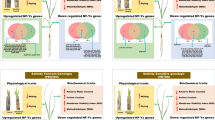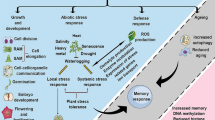Abstract
Cytochrome c oxidase (COX) is one of the principle enzymes involved in cell apoptosis in plants, due to oxidative stresses and mitochondrial dysfunction. In this study, hydroponic experiment was conduced to investigate transcriptional changes of six selected COX genes in rice seedlings (Oryza sativa L. cv. XZX 45) exposed to potassium chromate Cr(VI) or chromium nitrate Cr(III) using quantitative real-time RT-PCR. Uptake and accumulation of both Cr species by rice seedlings and their effect on COX activity were also determined. Results indicated that accumulation of Cr in rice tissues was evident, in which much more Cr was detected in roots rather than shoots from both Cr treatments. Significant increase in COX activity was only observed in shoots at the highest Cr treatment concentration from both Cr variants, whereas changes of COX activity in roots responded biphasically. Six selected target genes of COX1, COX2, COX5B, COX6A, COX6B, and COX7A from the rice COX gene family were expressed differentially in response to both Cr variants. Expression pattern of these selected COX genes was also variable in rice tissues. Information collected here suggests that selected COX genes from the rice COX gene family may play different roles during detoxification of Cr stress.






Similar content being viewed by others
References
Attallah CV, Welchen E, Martin AP, Spinelli SV, Bonnard G, Palatnik JF, Gonzalez DH (2011) Plants contain two SCO proteins that are differentially involved in cytochrome c oxidase function and copper and redox homeostasis. J Exp Bot 62:4281–4294
Comelli RN, Viola IL, Gonzalez DH (2009) Characterization of promoter elements required for expression and induction by sucrose of the Arabidopsis COX5b-1 nuclear gene, encoding the zinc-binding subunit of cytochrome c oxidase. Plant Mol Biol 69:729–743
De Santis A, Landi P, Genchi G (1999) Changes of mitochondrial properties in maize seedlings associated with selection for germination at low temperature: fatty acid composition, cytochrome c oxidase. Plant Physiol 119:743–754
Dixit V, Pandey V, Shyam R (2002) Chromium ions inactivate electron transport and enhance superoxide generation in vivo in pea (Pisum sativum L.cv. Azad) root mitochondria. Plant, Cell Environ 25:687–693
Ebbs SD, Piccinin RC, Goodger JQD, Kolev SD, Woodrow IE, Baker AJM (2008) Transport of ferrocyanide by two eucalypt species and sorghum. Int J Phytoremed 10:343–357
Fang Z, Zhao M, Zhen H, Chen L, Shi P, Huang Z (2014) Genotoxicity of tri- and hexavalent chromium compounds in vivo and their modes of action on DNA damage in vitro. PLoS ONE 9:103194
Feng M, Yin H, Peng H, Liu Z, Lu G, Dang Z (2017) Hexavalent chromium induced oxidative stress and apoptosis in Pycnoporus sanguineus. Environ Pollut 228:128–139
Fernandes MA, Santos MS, Alpoim MC, Madeira VM, Vicente JA (2002) Chromium(VI) interaction with plant and animal mitochondrial bioenergetics: a comparative study. J Biochem Mol Toxicol 16:53–63
Fiori A, Perez-Martinez X, Fox TD (2005) Overexpression of the COX2 translational activator, Pet111p, prevents translation of COX1 mRNA and cytochrome c oxidase assembly in mitochondria of Saccharomyces cerevisiae. Mol Microbiol 56:1689–1704
Fornuskova D, Stiburek L, Wenchich L, Vinsova K, Hansikova H, Zeman J (2010) Novel insights into the assembly and function of human nuclear-encoded cytochrome c oxidase subunits 4, 5a, 6a, 7a and 7b. Biochem J 428:363–374
García-Niño WR, Zazueta C, Tapia E, Pedraza-Chaverri J (2008) Curcumin attenuates Cr(VI)-induced ascites and changes in the activity of aconitase and F(1)F(0) ATPase and the ATP content in rat liver mitochondria. J Biochem Mol Toxicol 28:522–527
Hansen G (2000) Evidence for agrobacterium-induced apoptosis in maize cells. Mol Plant Microbe Interact 13:649–657
Hussain S, Yin H, Peng S, Khan FA, Khan F, Sameeullah M, Hussain HA, Huang J, Cui K, Nie L (2016) Comparative transcriptional profiling of primed and non-primed rice seedlings under submergence stress. Front Plant Sci 7:1125
Ikeda TM, Tsunewaki K (1996) Deficiency of cox1 gene expression in wheat plants with Aegilops columnaris cytoplasm. Curr Genet 30:509–514
Jin Y, Zhang S, Tao R, Huang J, He X, Qu L, Fu Z (2016) Oral exposure of mice to cadmium (II), chromium (VI) and their mixture induce oxidative- and endoplasmic reticulum-stress mediated apoptosis in the livers. Environ Toxicol 31:693–705
Kishi M, Yamamura Y, Kurihara T, Fukuhara N, Tsuruta K, Matsukura S, Hayashi T, Nakagawa M, Kuriyama M (1988) An autopsy case of mitochondrial encephalomyopathy: biochemical and electron microscopic studies of the brain. J Neurol Sci 86:31–40
Lai HY (2015) Subcellular distribution and chemical forms of cadmium in Impatiens walleriana in relation to its phytoextraction potential. Chemosphere 138:370–376
Lambertini L, Byun HM (2016) Mitochondrial epigenetics and environmental exposure. Curr Environ Health Rep 3:214–224
Larochette N, Decaudin D, Jacotot E, Brenner C, Marzo I, Susin SA, Zamzami N, Xie Z, Reed J, Kroemer G (1999) Arsenite induces apoptosis via a direct effect on the mitochondrial permeability transition pore. Exp Cell Res 249:413–421
Leung AW, Halestrap AP (2008) Recent progress in elucidating the molecular mechanism of the mitochondrial permeability transition pore. Biochim Biophys Acta 1777:946–952
Livak KJ, Schmittgen TD (2001) Analysis of relative gene expression data using real time quantitative PCR and the 2−ΔΔCT method. Methods 25:402–408
Lukina AO, Boutin C, Rowland O, Carpenter DJ (2016) Evaluating trivalent chromium toxicity on wild terrestrial and wetland plants. Chemosphere 162:355–364
Mittler R, Vanderaywera S, Gollery M, Van Breusegem F (2004) Reactive oxygen gene network of plants. Trends Plant Sci 9:490–498
Ostermeier C, Iwata S, Michel H (1996) Cytochrome c oxidase. Curr Opin Struct Biol 6:460–466
Otsuru M, Yu Y, Mizoi J, Kawamoto-Fujioka M, Wang J, Fujiki Y, Nishida I (2013) Mitochondrial phosphatidylethanolamine level modulates Cyt c oxidase activity to maintain respiration capacity in Arabidopsis thaliana rosette leaves. Plant Cell Physiol 54:1612–1619
Radin I, Mansilla N, Rödel G, Steinebrunner I (2015) The Arabidopsis COX11 homolog is essential for cytochrome c oxidase activity. Front Plant Sci 6:1091
Ray RR (2016) Adverse hematological effects of hexavalent chromium: an overview. Interdiscip Toxicol 9:55–65
Ren JH, Ma LQ, Sun HJ, Cai F, Luo J (2014) Antimony uptake, translocation and speciation in rice plants exposed to antimonite and antimonate. Sci Total Environ 475:83–89
Richter OM, Ludwig B (2003) Cytochrome c oxidase–structure, function, and physiology of a redox-driven molecular machine. Rev Physiol Biochem Pharmacol 147:47–74
Rossi SC, Wetterhahn KE (1989) Chromium(V) is produced upon reduction of chromate by mitochondrial electron transport chain complexes. Carcinogenesis 10:913–920
Sánchez-Martín FJ, Fan Y, Carreira V, Ovesen JL, Vonhandorf A, Xia Y, Puga A (2015) Long-term coexposure to hexavalent chromium and B[a]P causes tissue-specific differential biological effects in liver and gastrointestinal tract of mice. Toxicol Sci 146:52–64
Srinivasan S, Avadhani NG (2012) Cytochrome c oxidase dysfunction in oxidative stress. Free Radic Biol Med 53:1252–1263
Steinebrunner I, Landschreiber M, Krause-Buchholz U, Teichmann J, Rödel G (2011) HCC1, the Arabidopsis homologue of the yeast mitochondrial copper chaperone SCO1, is essential for embryonic development. J Exp Bot 62:319–330
Thompson CM, Proctor DM, Suh M, Haws LC, Kirman CR, Harris MA (2013) Assessment of the mode of action underlying development of rodent small intestinal tumors following oral exposure to hexavalent chromium and relevance to humans. Crit Rev Toxicol 43:244–274
Vacca RA, Valenti D, Bobba A, MeraWna RS, Passarella S, Marra E (2006) Cytochrome c is released in a reactive oxygen species dependent manner and is degraded via caspase-like proteases in tobacco bright-yellow 2 cells en route to heat shock-induced cell death. Plant Physiol 141:208–219
Vanhoudt N, Vandenhove H, Horemans N, Wannijn J, Buganic A, Vangronsveld J, Cuypers A (2010) Study of oxidative stress related responses induced in Arabidopsis thaliana following mixed exposure to uranium and cadmium. Plant Physiol Biochem 48:879–886
Yang M, Chen P, Peng H, Zhang H, Chen Y, Cai S, Lu Q, Guan C (2015) Cigarette smoke extract induces aberrant cytochrome-c oxidase subunit II methylation and apoptosis in human umbilical vascular endothelial cells. Am J Physiol Cell Physiol 308:378–384
Yu XZ, Zhang XH (2016) Determination of the Michaelis–Menten kinetics and the genes expression involved in phyto-degradation of cyanide and ferri-cyanide. Ecotoxicology 25:888–899
Yu XZ, Zhang FF, Liu W (2017a) Chromium-induced depression of 15N content and nitrate reductase activity in rice seedlings. Int J Environ Sci Technol 14:29–36
Yu XZ, Lin YJ, Fan WJ, Lu MR (2017b) The role of exogenous proline in amelioration of lipid peroxidation in rice seedlings exposed to Cr(VI). Int Biodeter Biodegra 123:106–112
Zar JH (1999) Biostatistical analysis, 4th edn. Prentice Hall, New Jersey, pp 231–261
Zeng F, Zhou W, Qiu B, Ali S, Wu F, Zhang G (2011) Subcellular distribution and chemical forms of chromium in rice plants suffering from different levels of chromium toxicity. J Plant Nutr Soil Sci 174:249–256
Zhang D, Ren L, Chen G, Zhang J, Reed BM, Shen X (2015) ROS-induced oxidative stress and apoptosis-like event directly affect the cell viability of cryopreserved embryogenic callus in Agapanthus praecox. Plant Cell Reg 34:1499–1513
Zhang Y, Xiao F, Liu X, Liu K, Zhou X, Zhong C (2017) Cr(VI) induces cytotoxicity in vitro through activation of ROS-mediated endoplasmic reticulum stress and mitochondrial dysfunction via the PI3 K/Akt signaling pathway. Toxicol In Vitro 41:232–244
Acknowledgements
This work was financially supported by the National Natural Science Foundation of China (No: 41761094) and the Guangxi Talent Highland for Hazardous Waste Disposal Industrialization.
Author information
Authors and Affiliations
Corresponding author
Ethics declarations
Conflict of interest
The authors declare that they have no conflict of interest.
Additional information
Editorial responsibility: M. Abbaspour.
Electronic supplementary material
Below is the link to the electronic supplementary material.
Rights and permissions
About this article
Cite this article
Yu, XZ., Lu, CJ., Lin, YJ. et al. Cr-induced disturbance on expression of six COX genes in rice seedlings. Int. J. Environ. Sci. Technol. 16, 2385–2394 (2019). https://doi.org/10.1007/s13762-018-1848-y
Received:
Revised:
Accepted:
Published:
Issue Date:
DOI: https://doi.org/10.1007/s13762-018-1848-y




